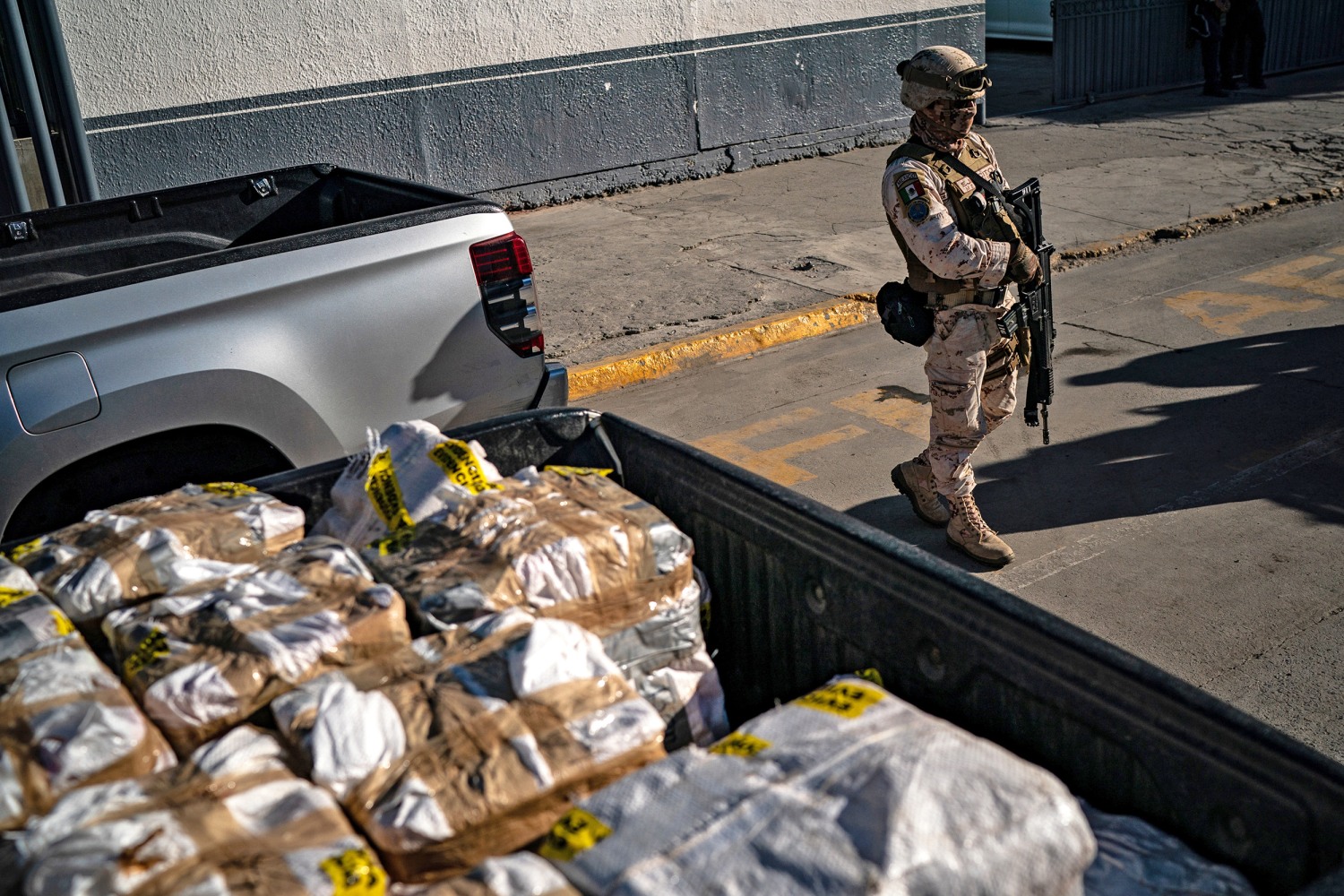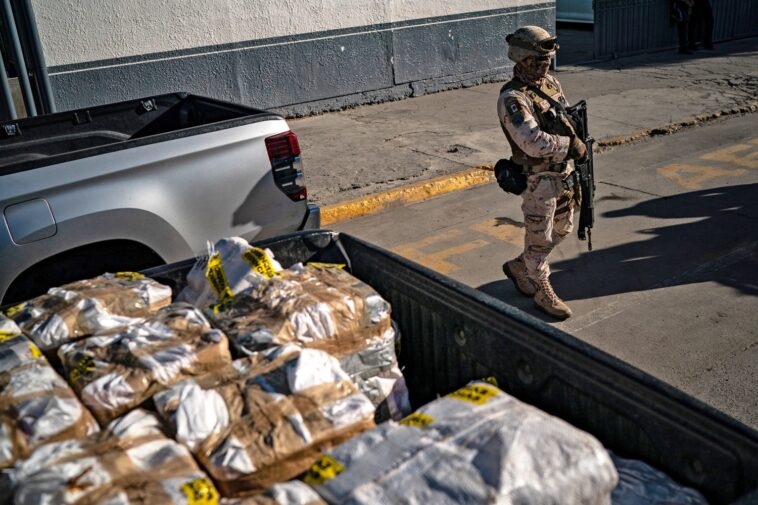
Operation Northern Border: A Closer Look at Mexico’s Bold Response
Mexico’s recent “Operation Northern Border” has sparked a great deal of conversation on both sides of the border. In this extensive opinion piece, we take a closer look at the operation that has led to the seizure of thousands of fentanyl pills and the arrest of over 2,000 individuals this year. With its origins loosely tied to political tensions and economic threats posed by the United States, this operation offers an interesting case study on how cross-border pressures can force a nation to act. It is an example that raises many questions about legal authority, border security, and political maneuvering within a climate full of tricky parts and tangled issues.
As Mexico’s military continues to publicize the daring operations conducted in its northern regions, especially in Sonora, there lies much to consider about the balance of power, the rule of law, and the broader implications on both countries’ policies. This editorial will dig into the methods, motivations, and potential repercussions of these actions while exploring the delicate legal and political dynamics at play.
Historical Context and the Political Gamble
Before we get into the nitty-gritty details of Operation Northern Border, it is important to understand the background. The operation was launched in early February, following a series of public statements made during a politically charged period in American politics. At the time, then-president Donald Trump had threatened Mexico with a sweeping tariff of 25% on all imported goods should the country fail to address its issues with drug trafficking. From a legal perspective, this threat wasn’t just an economic maneuver; it became a catalyst for Mexico to step up its enforcement measures against organized crime and drug smuggling.
This move represents a calculated political gamble. On one hand, by intensifying its patrols and operations near the U.S.-Mexico border, Mexico is signaling its commitment to curbing cartel activities. On the other hand, the decision to carry out high-profile arrests and seize highly potent drugs such as fentanyl also sends a message to domestic audiences that the government is taking bold steps to restore order. The timing and scale of actions under Operation Northern Border bring with them a series of challenging legal and political twists and turns that require close scrutiny.
Political Pressure and Economic Retaliation
One of the key factors underpinning Operation Northern Border was a strong sense of urgency in response to external pressure. U.S. political rhetoric, particularly threatening tariff measures, pushed Mexican authorities to demonstrate quick, tangible results in their war against drug cartels. This pressure created a scenario in which political posturing and law enforcement were tightly intertwined. The decision to step up enforcement actions—whether viewed as a proactive measure or a reactionary move to external pressures—reveals a multi-layered approach with both practical and political goals.
For many observers on both sides of the border, this intertwined relationship between U.S. threats and Mexican enforcement actions underscores a larger debate about sovereignty and mutual responsibility. The operation is not merely a matter of seizing contraband or arresting criminals; it is also a complex political statement made in the face of potential economic shutdowns. Such a stance underlines the importance of perceived responsiveness and decisive action, even when the methods involve risky legal and tactical maneuvers.
Legal Implications and the Enforcement Strategy
The legal framework supporting Operation Northern Border is replete with technicalities that underline the challenges of enforcing border security in an environment loaded with issues and dangerous unpredictabilities. The operation’s most significant legal component involves the massive confiscation of fentanyl, a drug classified as highly dangerous due to its potency. The legal justification for these seizures typically rests on anti-drug trafficking laws, yet the sheer scale and public visibility of the operation bring additional scrutiny.
Critics argue that while the operation demonstrates a strong commitment to law enforcement, it may also encroach on the legal rights of individuals, raising questions about due process. In cases of mass arrests, the tricky parts of legal interpretation come to the forefront. The enforcement agencies must ensure that each arrest is backed by sufficient evidence to stand the test of legal scrutiny. When laws are applied under the pressure of ensuring public safety, the possibility of missteps in procedural justice increases, leaving room for appeals and potential human rights concerns.
The challenge arises when law enforcement is required to balance public safety with individual rights in a scenario laden with competing interests. Below is a brief outline highlighting some of the most complicated pieces associated with enforcing anti-drug laws on the border:
- Ensuring that arrests are conducted without infringing on due process rights.
- Maintaining chain-of-custody in evidence collection during rapid seizures.
- Balancing aggressive tactics with the risk of collateral harm to innocent bystanders.
- Providing adequate legal support for those arrested to address concerns of potential abuse.
Each of these bullet points represents a small yet significant twist in the legal fabric that supports border security. When the law is put to the test in such heated circumstances, even the fine points of proper procedure can become sources of heated debate and legal controversy.
Economic Ramifications and the U.S.-Mexico Relationship
The operation’s origins are inextricably tied to economic diplomacy and the relationship between the United States and Mexico. The implementation of a potential 25% tariff had profound implications for bilateral trade and the broader economic landscape. In such an environment, where economic policies and national security measures intersect, every enforcement action resonates far beyond the immediate sphere of border security.
From an economic perspective, the operation serves as a reminder that legal actions often carry significant macroeconomic impacts. Tariff threats were enough to push a nation to take action against cartels, demonstrating that economic pressure can translate into stricter law enforcement measures. Many business leaders, analysts, and policymakers are closely examining how these actions could lead to pockets of economic instability or boost investor confidence depending on the perceived effectiveness of the operation.
Shifting Economic Paradigms
Critics and supporters alike point out that the economic implications of Operation Northern Border are not limited merely to the immediate region affected by drug smuggling. In fact, they carry a broader statement about how countries may use law enforcement operations as leverage in economic negotiations. If a country is seen as taking aggressive, effective measures to protect its borders, it may negotiate better trade deals and improve its international standing. Conversely, aggressive enforcement can also result in tensions that influence long-term trade relations.
This dual-edged impact calls for a balanced policy approach. Below is a table summarizing some of the key pros and cons associated with linking border enforcement operations to broader economic strategies:
| Pros | Cons |
|---|---|
|
|
These points highlight that the economic repercussions of Operation Northern Border are as layered as the legal and political ones. The decision-making process involves not only tactical choices on the ground but also calculated moves in the economic arena, where every action is weighed for its broader diplomatic impact.
Regional Dynamics and the Ripple Effect on Public Safety
The military’s role in the operation means that beyond legal and economic ramifications, there is also the critical question of how these actions affect local communities. In regions like Sonora, which is adjacent to the U.S. desert landscapes, increased security measures have both reassuring and challenging outcomes. While the large-scale arrests and seizures might boost public confidence about safety, they can simultaneously create nerve-racking situations for local residents who find themselves in the middle of these aggressive operations.
Community Perspectives and Law Enforcement Challenges
Residents of border cities and rural areas often report mixed feelings about these operations. On one hand, there is a sense of relief knowing that law enforcement is actively targeting dangerous elements operating in the shadows. On the other, the heightened presence of military forces and roadblocks can feel overwhelming and off-putting, stirring fears of over-policing and unintended collateral harm.
The tricky parts for law enforcement administrators involve managing public safety while also addressing the concerns of civil liberties. Below are some of the key issues that residents typically raise in discussions about border operations:
- Anxiety over rapid, large-scale arrests in their communities.
- Fears regarding the misuse of military powers in civilian areas.
- Uncertainties about the long-term impact on local businesses and community morale.
- A desire for more transparent communication from authorities regarding operations and legal safeguards.
These talking points shed light on the dual mandate of the government: protecting its citizens while ensuring that enforcement actions do not cross into areas that could harm the social fabric. The fine details of this balance often get lost in the broader narrative of success and security and lead to heated local debates where every decision by the authorities is scrutinized.
Enhanced Safety Measures Versus Inadvertent Public Challenges
There is also a broader dialogue taking place about how these enforcement measures might affect the delicate balance between maintaining order and upholding everyday freedoms. While the targeted seizure of dangerous narcotics is necessary, the approach taken to enforce these measures can sometimes contribute to a climate loaded with issues. Such a situation creates a scenario where security initiatives, while well-intentioned, must be coupled with measures to address and alleviate public fears.
This dynamic represents one of the more complicated pieces of the operation’s overall impact. Ensuring community safety is a noble goal, but achieving it without encroaching on personal freedoms requires a level of procedural thoroughness and community engagement that is not always present in such rapid, high-pressure operations. The outcome and effectiveness of these measures will likely continue to be debated for years to come, as additional data and community feedback become available.
Operational Tactics and the Legal Balance in Border Enforcement
The methods employed by Mexican military and law enforcement in Operation Northern Border offer ample opportunity for critical analysis of tactical decisions. The success of such an operation hinges on balancing rapid-response tactics with adherence to legal standards—a task that is both essential and nerve-racking. The following sections offer a closer look at operational tactics and the legal balance needed to manage these complicated pieces of the overall strategy.
Rapid Seizures and Arrest Protocols
At the heart of Operation Northern Border are the arrest protocols and the mechanisms for seizing contraband. Mexican authorities report that thousands of fentanyl pills have been confiscated and that more than 2,000 arrests have been made over a short duration. Such numbers signal an aggressive operational stance that intends to leave no stone unturned when it comes to drug trafficking activities.
The speed and scale of these operations, while intended to send a strong message to drug cartels, come with several legal and practical twists and turns. Among the most notable challenges are:
- Ensuring that the evidence collected remains admissible in legal settings.
- Securing swift judicial processes to handle the volume of arrests.
- Providing adequate legal representation for those detained.
- Maintaining public transparency on operational procedures and legal justifications.
All of these factors need to be carefully balanced to prevent legal backlashes that might undermine the operation’s overall goals. In a legal environment where every arrested individual has the right to a fair process, authorities must take time to figure a path through these subtle details without compromising on their mission. The tension between rapid law enforcement and judicial thoroughness presents one of the more twisted issues in modern border operations.
Legal Safeguards and Accountability
Every sovereign nation is tasked with the duty of ensuring that its law enforcement agencies have accountability mechanisms in place. In Brazil’s or Mexico’s case, especially in operations as extensive as the Northern Border initiative, there is an inherent need to confirm that all actions taken are in keeping with national laws and international standards. The delicate balance here is in providing enough operational freedom to disrupt illegal activities while at the same time safeguarding individual rights.
Some of the key accountability measures that are ideally part of such operations include:
- Independent oversight commissions reviewing operation procedures.
- Clear guidelines on the use of force and detention standards.
- Transparent reporting mechanisms that include data on seizures, arrests, and judicial outcomes.
- Regular audits by legal experts to ensure that no rights are inadvertently violated.
A uniform application of these safeguards is essential not only for reinforcing the legitimacy of the operation, but also for maintaining trust among the citizenry and the international community. Without such checks, aggressive border operations risk facing legal challenges that could unravel months or even years of diligent work.
The Broader Impact on U.S.-Mexico Cross-Border Dynamics
Beyond the immediate legal and economic spheres, Operation Northern Border has repercussions on the broader U.S.-Mexico relationship. Cross-border dynamics are always full of tricky parts and intertwined legal traditions, and this latest operation is no exception. The relationship between the two nations continues to evolve, reflecting a blend of cooperation and confrontation that is shaped by border security issues.
Diplomatic Repercussions and International Pressure
Every significant policy decision or enforcement action at the border sends ripples through international diplomatic circles. In this case, Mexico’s aggressive stance in seizing narcotics and making mass arrests is interpreted by many as not only an internal security measure but also as a diplomatic tool. On one side, the U.S. views these actions as necessary steps to combat cartel activities that directly affect American communities. On the other, there is concern that such aggressive actions might escalate tensions or generate unintended political fallout.
This type of diplomatic balancing act requires Mexican officials to manage sensitive legal details delicately. Both nations often end up having to sort out how their law enforcement actions are perceived internationally—whether as protective measures or as acts loaded with problems that could hinder cooperative efforts. Here are several of the key diplomatic concerns:
- The possibility of retaliatory economic measures or tariff adjustments by the U.S.
- Concerns over human rights violations and their impact on international perceptions.
- Challenges related to coordinating cross-border investigations and intelligence sharing.
- The risk of the operation being politicized in international media narratives.
The success of any border operation hence depends on its ability to avoid creating additional diplomatic friction while effectively tackling criminal elements operating in the shadows of international policy disputes.
Aligning Border Security with Transitional Economic Policies
In light of these diplomatic and legal challenges, both Mexico and the United States are forced to coordinate more closely on matters of border security and economic policy. This coordination is especially important given the historical precedent of using economic measures as a counterbalance to heightened security efforts. The tariffs proposed in response to the perceived laxity against drug trafficking, for instance, not only served as a catalyst for Operation Northern Border but also highlighted the intertwined nature of law enforcement and economic diplomacy.
This alignment is key to ensuring that borders do not become battlegrounds for broader geopolitical conflicts. The necessity to strike a balance between strong enforcement tactics and the respect for legal due process resonates well beyond the immediate picture of Mexican cartels—it speaks to the way modern states approach the governance of contested and loaded regions.
The Future: Evolving Legal Strategies and Policy Adjustments
Looking ahead, it is crucial to consider how operations like Northern Border will evolve in response to both legal challenges and the shifting sands of international policy. Law enforcement tactics and border security measures are rarely static. They must continuously adapt to emerging challenges, from new drug trafficking techniques to changing diplomatic pressures and advances in technology.
One likely future development could include a greater reliance on technology to track and identify cross-border criminal activities, thereby reducing the reliance on mass arrests and potentially minimizing the legal twists and turns that come from hurried operational raids. Additionally, policymakers on both sides might consider more focused approaches that balance aggressive tactics with robust legal safeguards—ensuring that each seizure or arrest stands up to legal scrutiny and contributes to a long-term strategic vision.
Refining Enforcement Techniques Amid Legal Scrutiny
With the potential evolution of legal strategies, enforcement agencies may adopt methods that incorporate both high-tech surveillance and community-based intelligence. By integrating these modern approaches, law enforcement can hopefully avoid some of the most challenging legal pitfalls that arise in mass operations such as Operation Northern Border. Consider the following potential improvements:
- Implementing advanced data analytics to identify smuggling patterns before they escalate into full-scale operations.
- Partnering with local communities to develop early-warning systems, ensuring that enforcement actions are targeted and precise.
- Investing in training programs that help soldiers and police officers manage the nerve-racking moments of quick-change situations with a better understanding of the legal standards required.
- Engaging regular reviews and feedback loops with independent legal experts to continuously refine the protocols in place.
These steps could help bridge the gap between a rapid enforcement approach and the necessity for careful legal scrutiny. They reflect a broader need to get into the hidden complexities of border security while ensuring that every action taken is underpinned by fairness and transparency.
Policy Reforms and Cross-Border Cooperation
Another aspect of the future strategy may involve comprehensive policy reforms that take into account both domestic legal systems and international cooperation frameworks. For Mexico, and indeed for the U.S., sharing best practices could serve as a method to manage the tangled legal bits of cross-border operations more effectively. Policy reforms that promote joint investigations, data-sharing agreements, and mutual legal assistance treaties may all contribute to a more balanced and successful counter-narcotics strategy.
In this light, the operation could be seen as a stepping stone—a necessary, though imperfect, response to immediate threats that also opens up a dialogue on the need for ongoing cooperation. By aligning legal frameworks and enforcement techniques, both countries can work together to tackle not only the visible manifestations of drug trafficking but also the underlying conditions that allow these criminal enterprises to flourish.
Conclusion: Balancing the Scales of Enforcement and Justice
In conclusion, Operation Northern Border represents a significant moment in the ongoing story of U.S.-Mexico relations and the fight against transnational organized crime. It is a tale of high stakes where legal obligations, economic pressures, and the intricacies of national security all converge in an environment full of tricky parts, tangled issues, and nerve-racking challenges.
The operation’s impressive seizure statistics and mass arrests are emblematic of a robust response to a pressing problem. However, they also serve as a reminder that enforcing the law in such high-pressure contexts involves a complicated interplay between rapid responsiveness and the need for precise legal details. From ensuring due process to balancing the diplomatic fallout, every aspect of Operation Northern Border is laden with subtle parts and hidden complexities that must be carefully weighed.
Both Mexicans and Americans watch these developments with a blend of hope and apprehension. On one hand, strict enforcement measures promise greater safety and curb the influence of dangerous cartels on both sides of the border. On the other, there is legitimate concern about how aggressive actions can sometimes entangle law enforcement in controversial legal debates that threaten to undermine public trust and cross-border cooperation.
Ultimately, the legacy of Operation Northern Border will depend not just on the immediate successes it has achieved in seizing drugs and arresting criminals, but also on how meticulously Mexican authorities manage the legal, economic, and diplomatic twists that come with operating in such a charged environment. The ability to figure a path through the maze of legal standards, community expectations, and international pressures will be critical in shaping not only the future of border enforcement but also the legal principles that underpin it.
Looking to the future, it is essential for policymakers and enforcement agencies in both Mexico and the United States to continue diving in and reexamining their approaches. Whether through refining enforcement techniques, implementing robust accountability measures, or negotiating policy reforms that reflect the ever-changing landscape of international security, the goal should always be to achieve a balanced response—in which public safety is maintained without sacrificing the foundational principles of justice and due process.
In this intricate dance of law, politics, and international relations, one thing remains clear: every decision and every operation, no matter how well-intentioned, carries with it both great promise and significant risk. As the story of Operation Northern Border unfolds, the world will continue to watch closely, hoping that in the pursuit of security, the scales of justice remain balanced.
While it is too early to measure the long-term effects of this mass enforcement approach, it is undoubtedly a pivotal chapter in modern border security policy. With future operations likely to build on the lessons learned here, the ongoing dialogue between legal experts, community representatives, and political leaders will play a super important role in steering both legal and diplomatic efforts in a direction that respects sovereignty, upholds the rule of law, and maintains public trust.
In the end, Operation Northern Border is not merely about seizing drugs or making arrests—it is about making a statement. It is about demonstrating a commitment, both to national sovereignty and international cooperation, that even in an era filled with daunting economic tariffs and challenging legal twists, a nation can stand firm in its efforts to secure its borders and defend the safety of its people. The coming years will tell whether this balanced approach can truly maintain peace along the border while ensuring that justice does not become collateral damage in the fight against transnational crime.
Originally Post From https://www.kjzz.org/fronteras-desk/2025-04-25/mexico-confiscating-drugs-making-arrests-in-operation-northern-border
Read more about this topic at
Migrants deterred by Trump’s border crackdown wait for …
Asylum-seekers pushed to new extremes in Mexico after …


